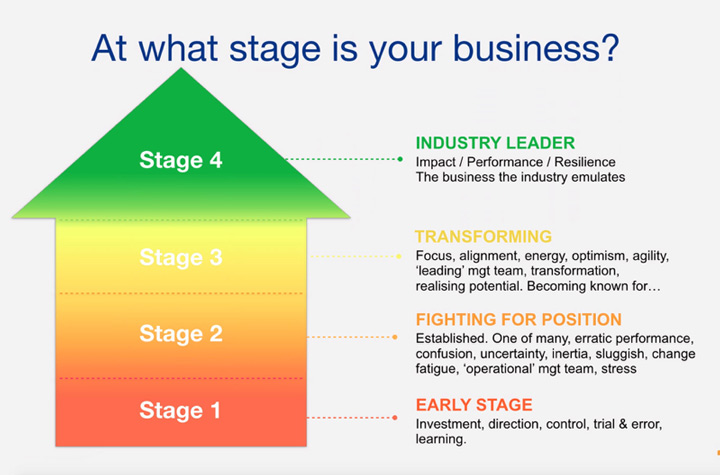“Industry Leadership” or “Fighting for Position.”
Which position have you chosen?
CEOs of private companies have numerous challenges to address navigating their business from one stage of growth to the next.
The graphic below highlights the various key stages of business growth and the common characteristics of each stage.

Businesses at Stage 1, ”Early Stage,” require energy and effort as their value proposition is constantly tested and challenged by customers
and market conditions. At this stage businesses are naturally agile and able to respond and change quickly while their strategy and execution management
process becomes more refined.
Stage 2, “Fighting for Position” is the most challenging. Businesses in this stage are well established, with a solid brand, loyal
customers and a a great track record of success. Their strategy has worked so far, but they are now facing significant internal and external pressures
that need a response. Customer demands may have changed, the competitive landscape my have changed with start-ups or well resourced competitors entering
the market with innovative business models. Despite seeing the changes happening in the marketplace the Leadership Team is focused on delivering Business
as Usual (BAU) as there is urgent client demand to service now as at this stage performance is often inconsistent.
High levels of stress are common for CEOs and Leadership Teams at this stage of growth as they have to exert considerable energy in overcoming the inertia
of BAU while at the same time figuring out the future picture of success . Often, they need to break away from the strategy and thinking that built
their success to-date. A key challenge is how to ‘unlearn’what has worked for them in the past, and discover new and better ways of doing
things that are more relevant to their changing conditions. Organisations at this stage can appear adrift; trying lots of new initiatives yet not truly
committing to these new ways leading to poor execution.
By contrast growth Stage 3 and 4 are very different. The ambiguity and uncertainty of the “Fighting for Position” stage has been overcome
and is replaced with commitment and confidence. Whilst there will always be challenges, an organisation that is in the “Transforming” stage knows the
thinking and skills they need and how to gain access; they’ve re-worked their strategy and have a clear execution process. They have identified the
source of future improved performance and while they are still on the “Fighting for Position” journey, they have clarity on how to break through.
Stage 4, attaining a position of “Industry Leadership” is a major breakthrough. Organisations positioned as leaders whether due to
product, service, or business model innovation, or market penetration have significant advantages. Being an Industry Leader in whatever capacity is
a massive platform to drive improved performance, it means your business is being recognised for the impact you see as your destiny and most importantly
you can build resilience to manage future challenges.
The enabling factors for driving successful business transformation:
Organisations seeking to move quickly through the stages of business growth towards industry leadership need to make a conscious choice to do so and
to work through the following:
- A shift in the mindset of the CEO and the Leadership Team. Business leaders need to be open and willing to look critically at the
way they do things now and accept new ways of doing things. Only those with a ‘growth mindset’ (Carol Dweck) will be able to identify and implement
the changes they need to make to transform their business. - Understand their risk appetite. Businesses committed to making the relevant changes
to their business need to be prepared to take measured risks to get there and apply the necessary resources to make these changes happen. - The “right strategy.” Strategy is really another word for ‘choices.’ There is a a “right
strategy’ for all organisations; a function of their winning aspiration, risk appetite and resource allocation. - A willingness to access the Collective Intelligence of an Advisory Board. CEOs are “commercially
lonely” and if there is no formal corporate board structure they can still access the necessary skills, new thinking, networks and accountability
framework via an Advisory Board.
TransformAction
Move quickly from aspiration to transformation:
Making the decision to break through to the next stage of growth is the first step. Businesses leaders whose desire to transform is greater than their
resistance to change, will get the most out of the TransformACTION process. As the name implies, it requires an equal balance of new thinking and doing
(action).
With the right process and a clear roadmap, decisions can be made with confidence and agility, inspiring your leadership team, people and customers and
navigating your business through transformation.
If you are a CEO looking to move through the stages of growth with agility and speed and have a burning ambition to lead your industry for more information
see here: https://www.leadyourindustry.com/. Programs are delivered one on one with organisations, in group workshops, in person and online.
The next TransformAction Strategic Planning Workshop is on February 7th 2020 for details and to register see here https://bit.ly/2lWfRnY
